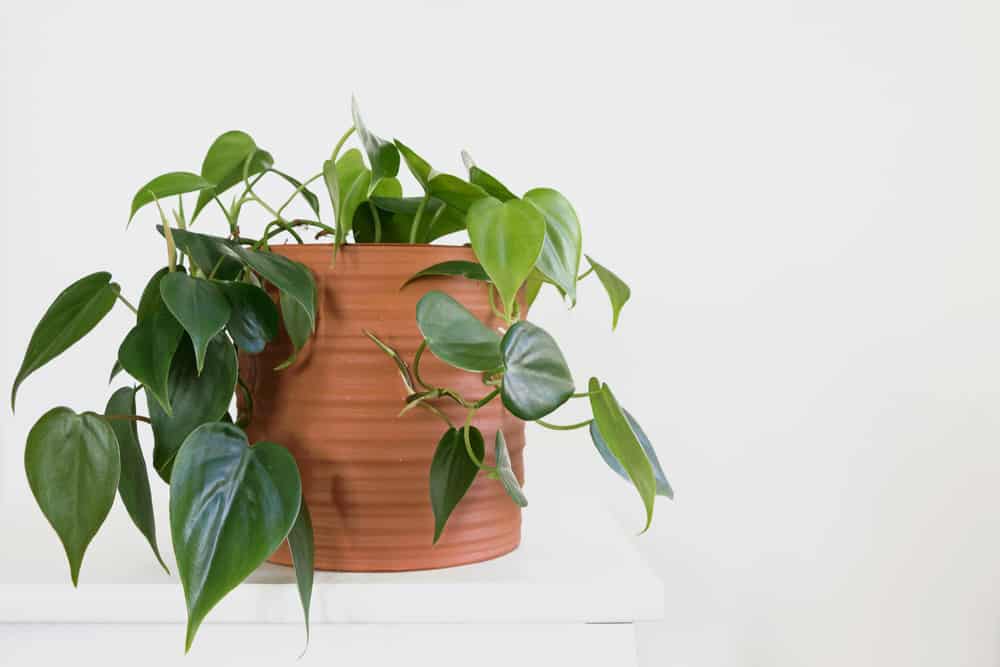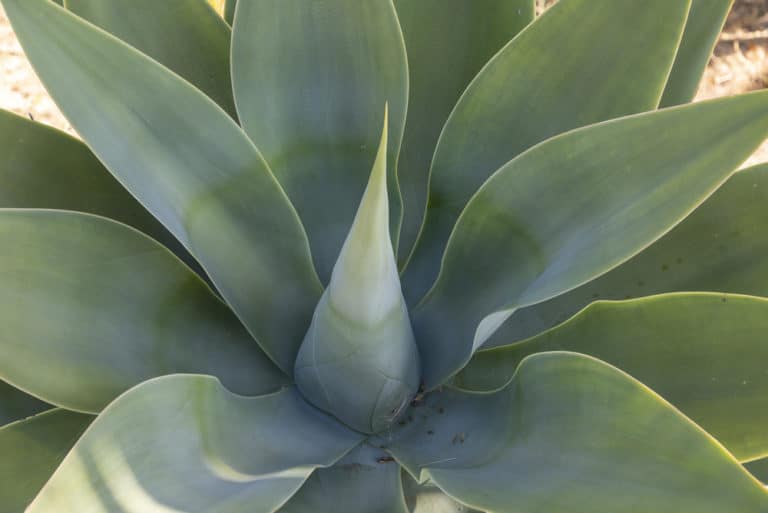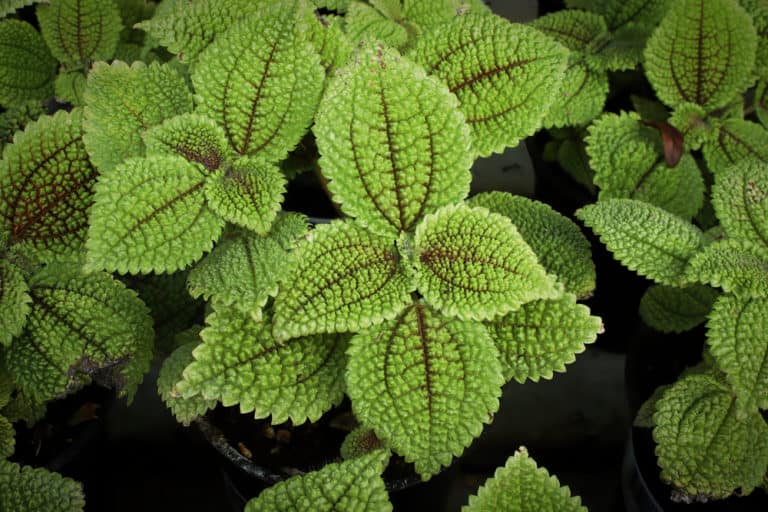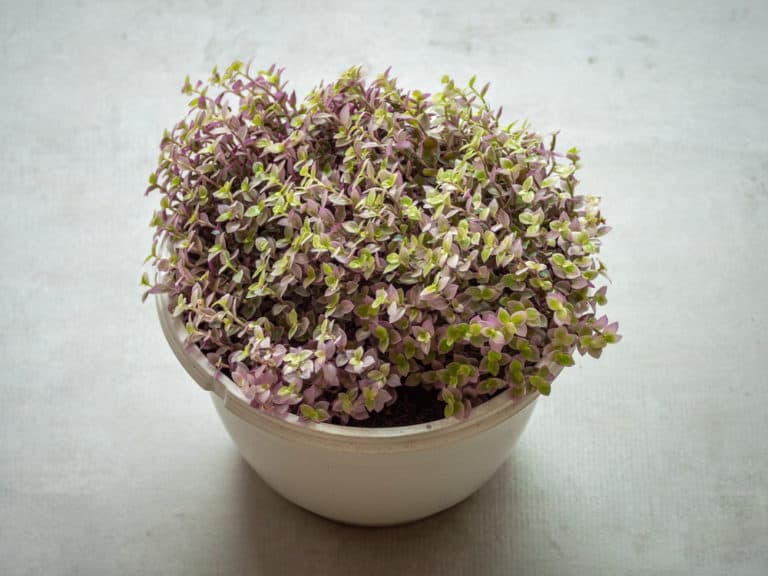Philodendron Hederaceum ‘Heartleaf’ Care Guide (2024)

The heartleaf philodendron is probably the most commonly grown houseplant and with good reason.
Philodendron hederaceum is almost impossible to kill, even for the least skilled indoor gardener and will grow in a wide range of environments.
Combined with the fresh-looking, evergreen leaves of this sprawling vine, this makes it an ideal choice for your home or office.
| Scientific Name | Philodendron hederaceum |
| Common Name | Heartleaf philodendron, Sweetheart plant |
| Light | Bright indirect sunlight |
| Watering | Water when the top 2 inches of the soil are dry |
| Temperature | 65 to 85ºF (18 to 29ºC) |
| Hardiness Zone | 9a to 11b |
| Humidity | 40 to 90% |
| Soil Type | Rich, quick-draining, loamy |
| Soil pH | 5.5 to 6 (acidic) |
| Fertilizing | A balanced feed once a month in spring and summer |
| Repotting | Every 1 to 2 years |
| Pruning | Spring or fall |
| Propagation | Root in water or soil |
| Toxicity | Toxic to humans and pets |
| Mature Size | 3 to 10-foot vines as a houseplant |
| Bloom Time | Rarely blooms indoors |
What’s Unique About Heartleaf philodendron?
The heartleaf philodendron plant is native to the rainforests of Central America and the Caribbean. Since it was first identified by plant explorers in the early 1800’s, it has been a popular houseplant.
The heartleaf philodendron plants have lovely evergreen leaves that cascade down their long vines, quickly giving your space a tropical feel.
Once you’ve mastered its few essential requirements, growing heartleaf philodendron is easy, even for a first time gardener.
And like all members of the araceae family, the heartleaf philodendron has been proven by a NASA study to be a good air purifier.
In effect, your heartleaf philodendron will not just beautify your environment, but make it a healthier place to be.
Heartleaf philodendron Care
In the steamy rainforests where the heartleaf philodendron originates, this tropical vine grows up the tall trees that form the canopy high above.
Your heartleaf philodendron plant care should strive to get conditions as close to this as possible, but heartleaf philodendron is quite forgiving.
For your Philodendron hederaceum care, focus on keeping it in bright but indirect light, in moist soil.
Light
Philodendron hederaceum light needs are defined by the conditions in which heartleaf philodendron plants evolved.
In the rainforest, the bright tropical sun passes through the tree canopy high overhead, so when it reaches the ground below it is reduced to dappled light.
Thus, heartleaf philodendron light requirements are for bright but indirect light, or between 10,000 to 20,000 lux.
A north or east window will give it just the right amount for healthy growth.
It will grow fairly well in even lower light conditions, including an office lit by just fluorescent lights.
However, full sun will damage the leaves and should be avoided at all costs.
Watering
It’s not always raining, even in the rainforests of Central America. In their winter season, rainfall is a lot lower than during the spring and summer.
So, heartleaf philodendron watering should reflect that pattern.
In spring and summer, you should water Philodendron hederaceum whenever the top 2 inches of the soil are dry. This will maintain consistently moist soil during its growing season.
However, as fall and winter approach, the heartleaf philodendron’s watering needs change.
Let the soil dry out almost completely between waterings. Then soak the soil, letting the excess run out.
Never use cold water straight from the tap. Let it warm to room temperature overnight. This also will allow the chemicals in the water to dissipate.
Temperature
The acceptable heartleaf philodendron temperature range is pretty generous, running from 65 to 85ºF (18 to 29ºC).
You should be able to provide an adequate temperature for Philodendron hederaceum in any indoor environment where you are comfortable.
To treat your heartleaf philodendron to some extra heat and humidity, take it outdoors to your patio or balcony in the steamy summer months.
However, be aware that heartleaf philodendron has a limited temperature tolerance. Below 60ºF (15ºC), growth will stop and the leaves can be damaged.
Keep your heartleaf philodendron away from drafts and windows in cold weather.
Of course, this tropical plant has no frost hardiness and must not be exposed to freezing temperatures.
Humidity
It should not come as a surprise that rainforests have high humidity. In its native habitat, heartleaf philodendron was used to a humidity level as high as 95%.
Even in your home, the ideal humidity for Philodendron hederaceum would be from 70 to 90%, but do not give up if that’s not possible.
At a minimum, the heartleaf philodendron humidity requirements are about 40% and up, and that’s usually quite standard in an indoor environment.
However, for the most luxuriant growth and biggest leaves, you can create a moister microclimate for your tropical plants.
Even just grouping them together helps raise the humidity in their immediate vicinity, but you can also add a small humidifier in their midst.
Soil
You do not need to get too fancy when it comes to your heartleaf philodendron soil.
The best soil for Philodendron hederaceum will hold moisture while still draining well, as the roots must never sit in water.
You need a pH level for Philodendron hederaceum of 5.5 to 6, or acidic, for best growth.
A standard indoor plant soil mix will work perfectly well for your heartleaf philodendron.
If you want, you can toss in some extra perlite or peat moss to open up the soil structure a little.
If you prefer, you can use an African Violet specialty mix without adding anything extra.
Fertilizer
While you might be able to get away without using a heartleaf philodendron fertilizer, you will get the most healthy growth with fertilizing once a month in spring and summer.
Basically, any time you see new leaves emerging is a good time to use fertilizer.
You can use a regular liquid houseplant fertilizer for Philodendron hederaceum, with a fertilizer ratio of 20-20-20.
However, you don’t want to burn the roots, so dilute it to half the recommended strength.
Pour it slowly over the surface of the soil right after you’ve watered.
Never let the solution get on the leaves, as it can burn them.
Potting & Repotting
You will know when it’s time for heartleaf philodendron repotting when the roots fill up the current pot. That may be once every year or two when it’s growing rapidly.
You may see roots growing out the bottom, or find a solid mass of roots if you pull it out of the pot.
When repotting Philodendron hederaceum, don’t be over-generous with the new pot size. Going up more than 2 inches in diameter will actually set back its progress.
As well, try to use an unglazed clay pot, which will let excess moisture wick out from the soil.
Even if your heartleaf philodendron doesn’t need a bigger pot, replacing the old potting soil with a fresh mix is a good idea.
Pruning
Because this vine can grow so rambunctiously, heartleaf philodendron pruning should be done once or twice a year. The best times are spring and fall.
Of course, no matter what the time of year, trim any dead or damaged leaves to keep your heartleaf philodendron looking its best.
While untrimmed vines can reach lengths of 10 feet or more, that can easily overwhelm a small space.
Do not be afraid to be ruthless when cutting off vines; you will be rewarded with healthy new growth.
When cutting Philodendron hederaceum stems, always leave a node right next to the cut. New growth will branch out from that point, creating denser vegetation.
Propagation
As you might expect from a plant that grows so quickly, heartleaf philodendron propagation is very easy, even if you’ve never done it before.
A good time to propagate Philodendron hederaceum is right after you’ve pruned your vines in spring, as you can use the stems you’ve just cut.
Cut the stems into 4 inch lengths, with the bottom cut just below a node. That’s where the new roots will form.
Strip off all but the top leaf or two.
Then, place the stems either in a jar of water or moist soil, and keep them in a warm, humid spot out of direct light.
In about a month, they should have developed enough roots that you can plant them out in their own little pots.
Also, make sure to check out our in-depth silver sword Philodendron plant care guide.
Common Problems of heartleaf philodendron
This would not be one of the easiest plants to grow if there were a lot of heartleaf philodendron problems.
However, even with this easy-care houseplant, you can have some problems with Philodendron hederaceum.
Keep an eye on the leaves, as they will usually give the first signs of any trouble with your heartleaf philodendron.
Pests
The most likely heartleaf philodendron pests include the common houseplant pests that you should always be on the lookout for.
The best way to prevent bugs from taking up residence on your Philodendron hederaceum is by spraying or wiping down the leaves once a month. Use some insecticidal soap or neem oil to keep insects away.
You are most likely to experience some problems with fungus gnats, as they are attracted to damp soil. If you see these little black flies around, drench the soil surface with a solution of water and hydrogen peroxide.
Aside from that, you may see some mealybugs, scale, or spider mites on the leaves. If you do, remove them by wiping them off with rubbing alcohol, or by spraying down the foliage with water.
Diseases
There are not very many heartleaf philodendron diseases, and you can prevent most of them by not overwatering and by keeping the leaves dry.
Philodendron hederaceum can develop fungal and bacterial diseases if damp conditions persist.
Root rot is a fungal disease that is likely to arise if the soil is consistently wet, rather than just moist. If the leaves start to turn yellow, accompanied by mushy stems, check the roots.
If some of them have turned black and stinky, you need to cut off all affected parts of your heartleaf philodendron, and then repot it in fresh soil in a clean pot.
Leaf spot can be a fungal or bacterial disease causing brown, yellow or black spots on the leaves. Cut them off and dispose of them in the garbage.
Growing Problems
Other growing problems are simply a consequence of your heartleaf philodendron not having good enough growing conditions.
Luckily, it’s usually a simple matter to improve its environment and cure a sick plant.
Brown leaves indicate that your heartleaf philodendron is getting scorched by too much sun. Find a shadier spot, or hang a light curtain between your plant and the sun.
Crispy leaf tips mean that your heartleaf philodendron needs more humidity. When in doubt, move it to your bathroom, where the steam from your showers will give it a boost.
Curling leaves are telling you that your heartleaf philodendron needs watering. If the soil is completely dry, you will need to soak the whole pot in a pail of water until it is completely wet.
Toxicity of heartleaf philodendron
Philodendron hederaceum may be easy to care for, but it can also pose a risk to you and your pets.
The calcium oxalate that is found in all parts of heartleaf philodendron is toxic to both humans and animals.
Its toxicity is because of the tiny crystals that can pierce tissues and cause pain or organ damage.
For Humans
Philodendron hederaceum is toxic to humans, although a severe enough reaction to require emergency medical care is rare.
However, it is important to know what to do if anyone, especially children, does end up eating a leaf of heartleaf philodendron.
Start by rinsing and spitting out any plant material in the mouth, and wiping away any that is left on the lips or face.
For localized topical pain, a popsicle or cold compress will dull the pain.
However, a swollen tongue or restricted airways are a medical emergency that you must not treat at home.
If you get some sap on your skin while tending your heartleaf philodendron, simply rinse it off to prevent a rash.
For Pets
Pets are more at risk when they ingest some of the heartleaf philodendron foliage, and you should not attempt to treat it yourself.
If your cat, dog, or rabbit is drooling excessively, vomiting, wheezing, or has diarrhea, take them to the veterinarian immediately. Animals can end up with permanent organ damage otherwise.
If you share your space with small creatures, take precautions to prevent these medical emergencies.
Grow your heartleaf philodendron in a hanging planter far off the floor, or let its vines trail down from a shelf near the ceiling.
Just make sure the vines are trimmed to stay out of reach.
Heartleaf philodendron Appearance
If you want a fresh, long-lasting evergreen vine to festoon your home or office, the heartleaf philodendron appearance is perfect.
The quick growth of this tropical native will soon create a cascade of greenery.
While you shouldn’t expect to get a Philodendron hederaceum flower inside, its heart-shaped leaves are absolutely lovely.
Foliage
The foliage of heartleaf philodendron, is, of course, the inspiration for its common name.
Its leaves have a symmetrical heart shape, with a long, narrow tip. They are 2 to 4 inches long.
When each leaf unfurls, it’s a bronze shade, but soon matures to a deep, glossy green. They have a thick, waxy texture.
When a heartleaf philodendron is grown outdoors in a tropical climate, the leaves can grow to a foot long, still maintaining their distinctive heart shape.
Because each evergreen leaf will stay on the plant for months, wipe them down once a month to keep them clean and looking their best.
Flowering
If you are growing this inside as a potted plant, do not expect to see your heartleaf philodendron flowering, as it stays in its juvenile phase indoors.
Blooming is only possible on a plant that has been grown outdoors in a year-round warm climate. That is the only way for it to reach maturity.
When a mature heartleaf philodendron does flower, you will see a spadix covered in tiny white flowers, surrounded by a yellow-green spathe. They’re about 6 inches long.
However, for the vast majority of heartleaf philodendron growers, you will have to settle for the luxuriant growth of the perfectly symmetrical leaves.
Size and Growth
Your heartleaf philodendron has a fast growth rate, up to 4 inches a week in its growing season.
However, because the full size of heartleaf philodendron grown indoors can be as much as 13 feet, it can still take up to 5 years to top out.
A heartleaf philodendron vine can be trained to grow up a sphagnum moss pole, which will actually improve its growth. The aerial roots will latch onto the moss, much as they would on a tree trunk in the rainforest.
This vining plant is also a natural choice for a hanging basket, letting its stems trail as far down as you want.
Heartleaf philodendron Fragrance
There is no heartleaf philodendron fragrance. The foliage has no scent, and a juvenile plant grown indoors will not bloom.
However, your heartleaf philodendron will improve the quality of your indoor air, as it filters out harmful chemicals such as formaldehyde.
Since the heartleaf philodendron does not have any fragrance that could trigger reactions in sensitive individuals, it’s perfect for public spaces.
Especially in a small space such as an office or studio apartment, a scented plant could soon be overwhelming.
If you do crave a botanical scent, try adding a few drops of a floral essential oil when you wipe down the leaves of your heartleaf philodendron.
Suggested Uses for heartleaf philodendron
Almost any indoors space could benefit from the inclusion of a heartleaf philodendron plant.
It’s great for a bedroom, where a hanging planter will add a welcome green accent as well as purify the air as you sleep.
In a one-room apartment, you can train it across a trellis or hang a series of baskets to screen off a sleeping corner.
Take your heartleaf philodendron outdoors to the deck or balcony for the summer to create your own tropical oasis in the city.
Even in a small space, you can train it up a moss pole to fill in what would otherwise be an underused corner.
FAQ
What is heartleaf philodendron?
The heartleaf philodendron is an evergreen vine that originated in the rainforests of Central America and the Caribbean. It is commonly grown as an indoors potted plant.
How to identify heartleaf philodendron?
The heartleaf philodendron has symmetrical heart-shaped glossy leaves that grow on long trailing or climbing stems. The thick, waxy leaves are bronze when new, changing to a bright green.
How to care for heartleaf philodendron?
The heartleaf philodendron should be kept in a warm, humid environment, in moist soil and in bright but indirect light. Fertilize regularly and prune to keep it neat.
How to grow heartleaf philodendron indoors?
The heartleaf philodendron can be grown indoors as a potted plant, either as a climbing vine or with trailing stems. It can be grown under artificial or natural lights.
How to grow heartleaf philodendron outdoors?
The heartleaf philodendron can be planted in moist soil in a shady location in a tropical or subtropical climate. Give it regular waterings and provide it with something to climb.
How fast does heartleaf philodendron grow?
The heartleaf philodendron can grow as much as 4 inches a week during its growing season of spring and summer, reaching its full size in up to 5 years.
How tall does heartleaf philodendron grow?
The heartleaf philodendron vines can extend from 3 to 13 feet when grown indoors, depending on how much you prune. Outdoors, a mature vine can be more than 20 feet.
How to make heartleaf philodendron grow faster?
The heartleaf philodendron will grow its fastest with bright but indirect light, hot and humid conditions, and regular fertilizing. A climbing plant will grow faster than one that trails.
How to stake heartleaf philodendron?
The heartleaf philodendron can be trained to grow up a sphagnum moss pole, which replicates how it climbs up tree trunks in its native rainforest habitat.
How to pot heartleaf philodendron?
The heartleaf philodendron should be planted in rich but well-draining soil, in an unglazed clay pot which will allow the soil and roots to breathe.
How to revive heartleaf philodendron?
If the soil of your heartleaf philodendron has completely dried out, you can soak the whole pot in a pail of water or a sink.
Why is my heartleaf philodendron dying?
If your heartleaf philodendron has a fungal or bacterial disease, it is probably because of overly wet conditions. Cut out all infected parts and repot.
Why is my heartleaf philodendron drooping?
If your heartleaf philodendron is drooping, it could be too wet or too dry. Check the soil and either give it a good soaking or replant it in fresh, porous soil.
How cold can heartleaf philodendron tolerate?
The heartleaf philodendron will start to suffer leaf and stem damage at temperatures lower than 60ºF (15ºC), and frost or freezing temperatures will kill it.
How to get rid of pests on heartleaf philodendron?
Insects can be prevented on the heartleaf philodendron by spraying or wiping down the foliage every month with neem oil or insecticidal soap mixture.
Is heartleaf philodendron toxic to cats?
Yes, heartleaf philodendron is toxic to cats. If your cat has eaten some of the foliage and is wheezing or vomiting, take it to the veterinarian at once.
Is heartleaf philodendron toxic to dogs?
Yes, heartleaf philodendron is toxic to dogs. If your dog is drooling excessively, wheezing, vomiting, or has diarrhea, take it to the vet as soon as possible.
Is heartleaf philodendron toxic to children?
Yes, heartleaf philodendrons are toxic to children. Serious reactions are rare, but if your child has a swollen tongue or trouble breathing, take them to the emergency room.
Is heartleaf philodendron toxic to humans?
Yes, heartleaf philodendron is toxic to humans. If you get some of the sap on your skin, rinse it off to avoid a rash from the calcium oxalate crystals.
Does heartleaf philodendron have a scent?
No, the heartleaf philodendron foliage has no fragrance, and the vines never flower indoors. It is suitable for use wherever fragrant plants are not allowed.






